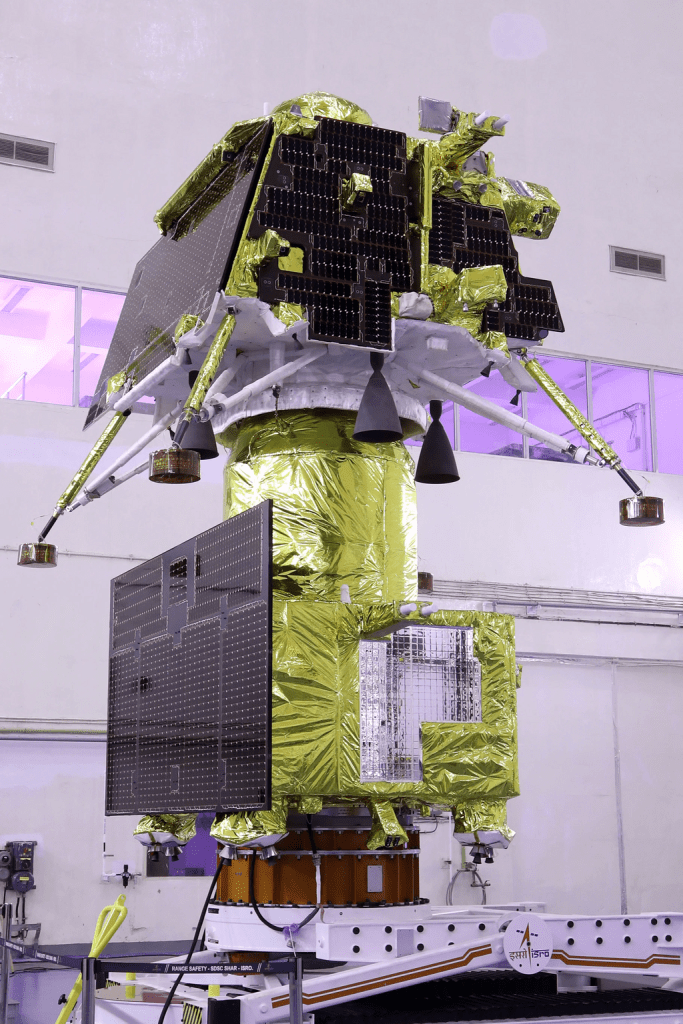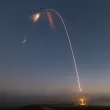Featured image: ISRO
Lift Off Time | July 14, 2023 – 9:05 UTC | 14:35 IST |
|---|---|
Mission Name | Chandrayaan-3 |
Launch Provider | Indian Space Research Organisation (ISRO) |
Customer | Indian Space Research Organisation (ISRO) |
Rocket | LVM-3 |
Launch Location | Satish Dhawan Space Centre, Andhra Pradesh, India |
Payload mass | 3,900 kg |
Where is the spacecraft going? | The moon! The planned landing site coordinates are 69.367621 S, 32.348126 E |
Will they be attempting to recover the first stage? | No, this is not a capability of the rocket |
Where will the first stage land? | Unknown |
Will they be attempting to recover the fairings? | No, this is not a capability of the rocket |
Are these fairings new? | Yes |
How’s the weather looking? | TBD |
This will be the: | – 89th ISRO mission – 5th ISRO mission of 2023 – 7th LVM-3 mission – 2nd LVM-3 mission of 2023 – 104th orbital launch attempt of 2023 |
Where to watch | If available, an official livestream will be listed here |
What Does All This Mean?
The Indian Space Research Organisation (ISRO) is preparing for the launch their Chandrayaan-3 lunar exploration mission, which will launch atop a LVM-3 rocket from the Satish Dhawan Space Centre. This mission is a repeat of the Chandrayaan-2 mission which failed in its soft-landing attempt on the lunar surface, and will be the third overall lunar exploration mission for the ISRO.
Chandrayaan-3
The Chandrayaan-3 (Chandrayaan means “mooncraft”) is a planned lunar exploration mission conducted by the Indian Space Research Organisation (ISRO). This mission follows the Chandrayaan-2 mission in August 2019, where the rocket launched successfully, but a last-minute software glitch in the soft-landing guidance software caused the lander to crash into the surface of the moon during the landing attempt.
The launch of Chandrayaan-3 is scheduled for July 14, 2023, and the landing module is expected to touch down on the lunar surface on August 23, 2023 at the following coordinates, 69.367621 S, 32.348126 E.
The ISRO have stated three main objectives for this mission:
- To have a safe and soft landing on the moon.
- To demonstrate the rovers capabilities on the lunar surface.
- To carry out in-situ scientific experiments.

The spacecraft consists of two modules. The first is the propulsion module, which weighs 2148 kg. This module will act as a communication relay satellite, carrying the landing module until the spacecraft reaches a 100 km lunar orbit. The propulsion module will also carry a payload called Spectro-polarimetry of Habitable Planet Earth (SHAPE), which will study the spectral and polarimetric measurements of Earth from the lunar orbit. The module has a box-like structure with a large solar panel mounted on one side and a large cylinder on top (the Intermodular Adapter Cone), which is a mount for the landing module.
The second module is the Vikram landing module, which weighs 1752 kg. This is also box-shaped module and it has four landing legs and four landing thrusters. The landing module includes a rover, the Pragyan (which weighs 26 kg), as well as several payloads:
- Chandra’s Surface Thermophysical Experiment (ChaSTE) to measure thermal conductivity and temperature
- Instrument for Lunar Seismic Activity (ILSA) for measuring the seismicity around the landing site
- A passive Laser Retroreflector Array from NASA accommodated for lunar laser ranging studies
The rover itself will carry two payloads: an Alpha Particle X-ray Spectrometer (APXS) and Laser Induced Breakdown Spectroscope (LIBS).
What Is The LVM-3?
The Launch Vehicle Mark-III (LVM3) is a three stage, medium lift rocket developed by the Indian Space Research Organisation (ISRO). The main purpose of the vehicle is to launch communication satellites into geostationary orbit, though there are plans to use the rocket for crewed launches in the future.

First Stage
The first stage of the launch vehicle consists of a pair of S200 solid rocket boosters. Each booster runs on hydroxyl-terminated polybutadiene (HPTB) and is 3.2 meters wide and 25 meters long. Each SRB carries 207 tonnes of propellant which is burned through in 128 seconds. Overall, each booster produces a peak thrust of 5,150 kN and 274.5 seconds of Isp.
Both boosters are equipped with a flex nozzle that can be vectored to control the vehicle’s pitch, roll, and yaw. Somewhat interestingly, the hydraulic fluid used to move the nozzle is stored at the base of each booster in a small tank.
Second Stage
The second stage (designated L110) is an air-lit core stage that is four meters in diameter and 21.39 meters tall. Equipped with two Vikas gas generator-powered engines, the second stage produces 1,598 kN of thrust with 293 seconds of Isp. This Isp is somewhat low compared to other gas generator engines due to the use of hypergolic propellants; the engines run on UDMH and N2O4.
Like one the first stage, because both Vikas engines are capable of gimbaling, the engines provide pitch, yaw, and roll control to the vehicle.
The second stage ignites 114 seconds after launch and burns for ~200 seconds. Shortly before ignition, the vehicle sheds the “nozzle closure system,” which is used to protect the Vikas engines from the SRB exhaust during ascent. This is not a problem on sustainer stages, like the space shuttle and SLS, since the RS-25 engines are ignited before the SRBs, protecting the engine.
Third Stage
Atop the core second stage sits a cryogenic third stage, designated C25. This stage is also four meters in diameter and 13.5 meters long. The engine runs on liquid oxygen (LOX) and liquid hydrogen (LH2), giving the stage a specific impulse of 442 seconds. The stage is equipped with a single CE-20 engine, which runs on the gas generator cycle and produces 186 kN of thrust.




Will Tim be live for this launch ?? Like the last time
Where will the boosters fall of?
In the sea?
Is this process programmed too?